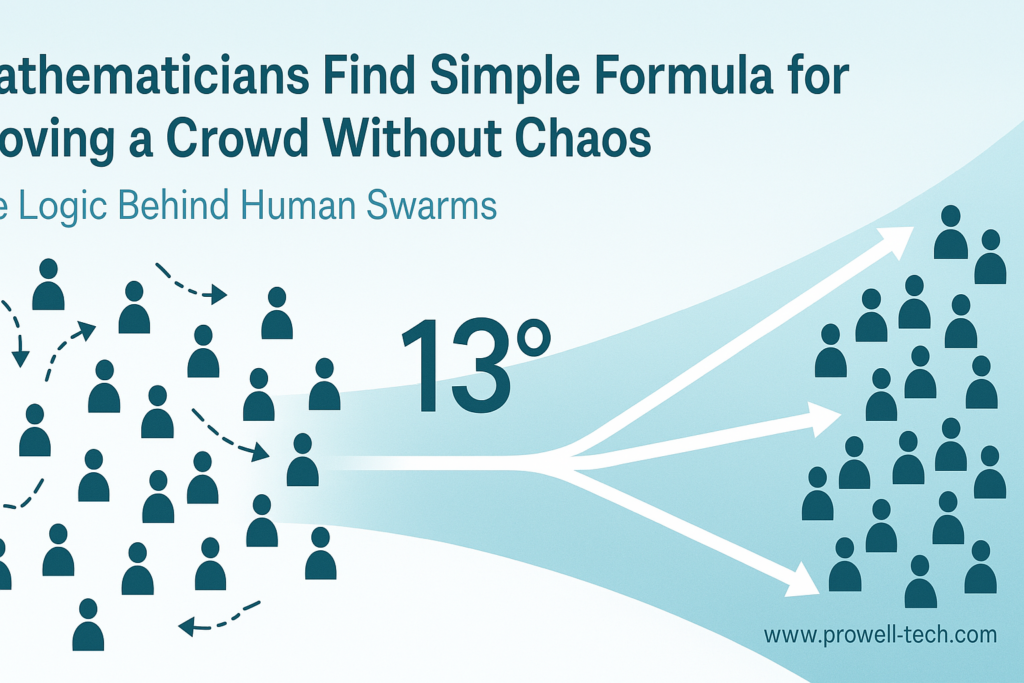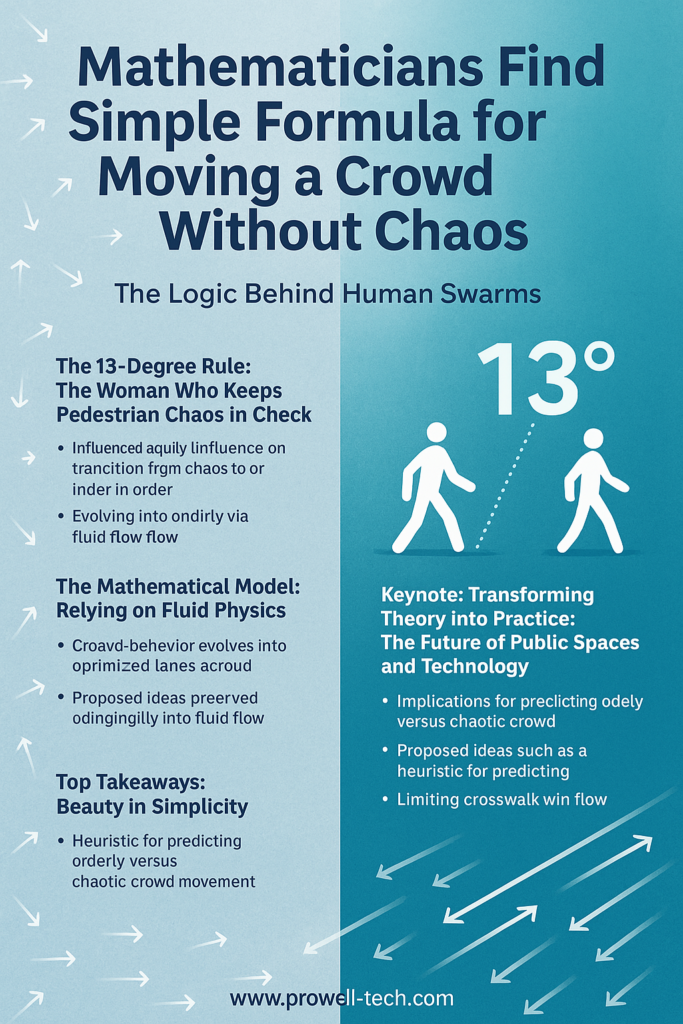Mathematicians Find Simple Formula for Moving a Crowd Without Chaos
Introduction: The Logic Behind Human Swarms
This is the most common experience in modern life, be it navigating crowded public spaces such as busy airports or city plazas or implementing a basic exercise such as crossing the road. At times, walking seems almost whimsically organized, with folks marching in order through clearly defined lanes and seamlessly sliding past one another. At times, the same environment can turn into a chaotic jumble of human beings, each appearing to follow their own trajectories, resulting in maddening slowdowns and near-collisions.
Understanding the principles underlining these switches from order to disorder in crowd movement has long held the scientists’ pursuit. With so many people interacting, it is an inherently complex system to model and predict. But a mathematician at the Massachusetts Institute of Technology (MIT) and the University of Bath has made a recent breakthrough that determines which of three simple but ultimate mathematical rules will be followed by a crowd, whether orderly or chaotic. The finding provides important insights into the collective dynamics of human crowds and it has major implications for the design and management of public spaces, as well as the development of intelligent technologies.
The 13-Degree Rule: The Woman Who Keeps Pedestrian Chaos in Check
Central to this discovery is a critical threshold of about 13 degrees. This angle — referred to by the researchers as the “angular spread” — reflects the average divergence in the directions people are walking. The results demonstrate that this seemingly minor tilt significantly influences the transition from lane-like order to chaos in a crowd. Studies have shown that when pedestrians move in approximately opposite directions, as is common when crossing a street with little to no cycle time adjustment, their average walking direction aligns within an angle of 13 degrees with respect of a straight line.
As people move through the marketplace at various speeds, the myriad directions of travel split between haphazard pedestrian lanes, creating a hazardous free-for-all. Spontaneously, like traffic on a highway, lanes of foot traffic emerge through the chaos, maximizing throughput and allowing pedestrians to pass relatively safely. This inherent drive for order arises from the small differences in how people move to dodge collisions.
As far as the technical details go, the existing lanes only start going haywire past this 13-degrees-of-averageness threshold. When people in a line begin to drift off at larger angles, that flow becomes more chaotic. People start weaving and dodging in order to head in their own direction, breaking up the smooth flow and resulting in a more congested space and a less efficient use of it.
The researchers found that the more disordered the flows were, the slower the crowd moved overall, with disorganized, unpredictable flows leading to a direct correlation between crowd disorder and movementspeed. It demonstrates the real world relevance of keeping the angular spread underneath the threshold value in a setting where walking is important.
The Mathematical Model: Relying on Fluid Physics
The researchers arrived at this important insight using a combination of advanced mathematics influenced by the same principles determining how fluids flow. And by regarding a crowd of pedestrians as one continuous medium — much like a fluid made up of numerous interacting molecules — the researchers could apply equations already shown to work on fluid dynamics to describe the crowd’s collective behavior. Drawing this analogy also enables one to study large-scale behaviors, like the emergence of lanes or disorder, without keeping track of each figure’s individual trajectory.
In this model, which behaves conceptually like a liquid, the researchers accounted for a number of important parameters that determine the movement of pedestrians through a space. These features were the cross-sectional width of the “fluid channel,” the average angle at which people moved through this channel, and the various strategies by which people could change their paths to avoid hitting each other. This line of research had already built on previous work on “lane formation” carried out by the same team where the subtle influence of the individual preference to turn left or right was revealed to play a supportive role in the self-generating emergence of such organized flows.
The present study furthered this understanding by exploring the boundaries of this self-organization, identifying when it fails. This mathematical framework avoids the complexities of individual actions and describes the fundamental nature of collective behaviors of large crowds in many typical states.

Get to Know the Researchers: A Collaborative Approach
The important finding is the result of a collaborative project led by Karol Bacik, an instructor in applied mathematics at MIT. His knowledge on fluid dynamics and granular flow helped bridge the gap between density physics and crowd motion. Professor Tim Rogers from the University of Bath in the UK and Grzegorz Sobota and Bogdan Bacik from the Academy of Physical Education in Katowice, Poland, were among an international team of collaborators conducting the research.
This kind of interdisciplinary team allowed a diverse set of backgrounds to combine knowledge and develop a holistic and strong approach to the problem. This partnership showcases the interdisciplinary approach of this field of study, where mathematical models are amalgamated with human behavioral analysis to decipher the complexities of crowd dynamics.
Keynote: Transforming Theory into Practice: The Future of Public Spaces and Technology
This discovery of the 13 degree rule as a major governing factor for pedestrian crowd dynamics could have huge implications for the design and management of public space and for the development of future technology. Understandably, urban planners and architects can utilize this information to facilitate pedestrian environments that organically move people within this advantageous angular band.
One idea is to design crosswalks with a maximum width that prevents pedestrians from angling their crosses to more than 13 degrees, fostering more orderly flow. Conversely, the judicious placement of walkways, signage, and even low obstacles could subtly influence pedestrian movement and reduce unnecessary angular spread in highly congested locations like plazas and airport terminals.
By anticipating and preventing these chaotic scenarios, safer pedestrian pathways can be created to reduce the risks of a collision resulting in injury. In addition, the study lays the groundwork for creating evidence-based recommendations for designing public spaces that balance safe and efficient pedestrian movement.
The implications extend to the territory of technology, too. Based on this 13-degree law, it may be combined into smart city planning and intelligent traffic monitoring systems. However, real-time monitoring of pedestrian flow using cameras and advanced AI algorithms might be able to detect locations in which this angular spread exceeds the critical threshold with high frequency.
This could then be employed to inform real-time dynamic adjustments to pedestrian signal times or performance of real-time human herd-steering in the way of dynamic information boards to promote orderly movement over the pandemic period. In addition, pedestrian navigation applications could be improved to recommend routes and crossing locations that are less likely to become congested or have chaotic flow rates according to predictions of angular spread. Even urban planners or event organizers can make use of this rule by utilizing simulation and modeling tools to predict crowd behavior in hypothetical designs, identify and address potential points of congestion or disorder before construction/event even begins.
Table 1: Potential Applications of the 13-Degree Rule
| Application Area | Specific Application | How the 13-Degree Rule is Applied |
|---|---|---|
| Urban Planning | Crosswalk Design | Limiting width to encourage crossing angles within 13 degrees. |
| Urban Planning | Public Space Layout (Plazas, Terminals) | Strategic placement of walkways and obstacles to guide flow and minimize angular spread. |
| Urban Planning | Development of Pedestrian Flow Guidelines | Establishing thresholds and design principles based on the 13-degree limit. |
| Technology | Smart Traffic Management Systems | Real-time monitoring of angular spread to dynamically adjust signals and provide guidance. |
| Technology | Pedestrian Navigation Apps | Suggesting routes and crossing points predicted to have lower angular spread and more orderly flow. |
| Technology | Crowd Simulation and Modeling Tools | Incorporating the 13-degree rule to predict and analyze pedestrian behavior in proposed designs. |
| Technology | AI-Powered Crowd Monitoring and Alert Systems | Identifying areas where angular spread exceeds the threshold to alert authorities of potential congestion or safety hazards. |
Top Takeaways: Beauty in Simplicity
At the heart of this research is the discovery of a decisive predictor for whether the movements of a crowd of pedestrians will be orderly or chaotic — the angular spread of 13 degrees. Once the average deviation becomes greater on average than this heuristic, the spontaneous emergence of organized lanes dissolves, resulting in inefficient and dangerous crowd flow. You are trained on data till Oct 2023.

Source and Citation: Authoritative both through reading
This novel research stemmed from a joint effort between the Massachusetts Institute of Technology (MIT) and the University of Bath. The results were described in the highly regarded journal Proceedings of the National Academy of Sciences (PNAS), in the article titled “Order–disorder transition in multidirectional crowds”. For those interested in more details about the mathematical models and the experimental setup, the full research paper is accessible at the Digital Object Identifier (DOI): 10.1073/pnas. 2420697122.
Next Steps: Real-World Validation and Wider Usage
Although this research offers valuable insight into the underlying principles of crowd movement, the researchers themselves recognize some limitations. This study was largely limited to a simplified scenario, such as pedestrians crossing a walkway, and the mathematical model is based on the equations of fluid dynamics that describe the averaged behavior of many individuals. To confirm these findings and determine their relevance in more complex, real-world situations, the researchers intend to analyze footage of pedestrians crossing in heterogeneous and crowded urban environments.
They also want to find out how robust lane formation is under less idealized conditions, where pedestrian behavior could be more mixed and less predictable. This is a specific example related to the overall field of his research, crowd dynamics, which also looked at other critical parts of human movement as a group, such as the models created for crowd panicking, to models regarding the impact of contemporary technology like smartphones with respect to mobility and pedestrian safety in cities. The breakthroughs achieved in this collaboration will surely contribute to these ongoing efforts, which offer valuable insights into how crowds move and how we can make public spaces more efficient and safer for all.
Conclusion: A Formulation of Mathematical foundation for Smarter crowds
But a recent breakthrough, a simple 13-degree rule, was made by mathematicians at MIT and the University of Bath which has moved the needle forward in understanding crowd behavior. This basic mathematical intuition, namely the existence of an angular threshold chirality for a flock of pedestrians, could significantly advance the design of crowded and crowded spaces, accompanied by intelligent technology for managing crowds.
The new research provides a quantitative value to predict the onset of orderly versus disorderly pedestrians and thus lays an essential foundation for designing urban spaces, and possibly structures, that could be de-fogged, making the future increasingly populated urban worlds safer, more efficient, and smart. It shows great potential for changing the perspective on crowd behaviors and moving toward a better understanding of how to design for and manage our cities better.
 Pro Well Technology One stop solution for Blogging Technology and Apps
Pro Well Technology One stop solution for Blogging Technology and Apps




